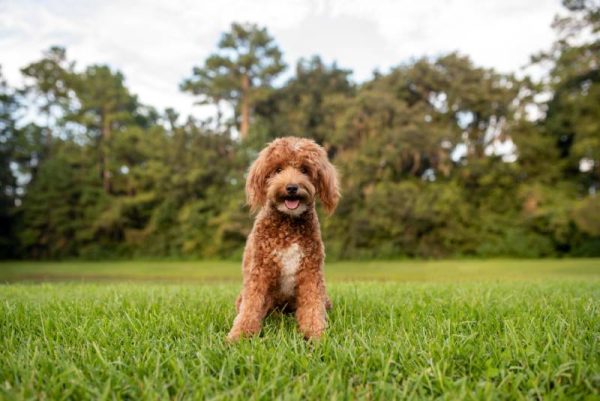Click to Skip Ahead
Goldendoodles burst onto the scene in the 1990s and quickly became popular for their versatility and family-friendliness. A cross between a Golden Retriever and a Poodle, the low-shedding Goldendoodle can inherit a real rainbow of colors from the parent breeds (especially the Poodle), including a rich and striking red.
In this post, we’ll rewind a few decades to take you back to the red Goldendoodle’s beginnings and how they came to be so beloved today.
Breed Overview
Height:
Up to 15 inches (Toy), 16–20 inches (Mini), up to 24 inches (Standard)
Weight:
20–35 pounds (Toy), 35–50 pounds (Mini), 55–70 pounds (Standard)
Lifespan:
10–15 years
Colors:
Red, cream, golden, silver, blue, apricot, black, chocolate, silver beige, gray, merle, brindle, phantom
Suitable for:
Any loving family, including families with children and first-time dog parents
Temperament:
Fun-loving, friendly, patient, intelligent, playful
In addition to an array of possible coat colors, the Goldendoodle’s size versatility is an extra perk for fans of this much-loved mixed breed. Breeders typically produce Goldendoodles in Toy, Mini, and Standard sizes, though the terms may vary from breeder to breeder.
For example, some breeders refer to Miniature Goldendoodles as “medium.” Goldendoodles are well-adapted to both city life and rural life as long as they get enough exercise.
Red Goldendoodle Characteristics
The Earliest Records of Red Goldendoodles in History
Breeders in both the US and Australia began developing Goldendoodles in the 1990s. The intention was to develop a dog that was intelligent, gentle, trainable, and low-shedding to appeal to allergy sufferers.
Both parent breeds—the Poodle and the Golden Retriever—brought something special to this mix. While the Golden Retriever contributed a sweet, patient temperament and high trainability, the Poodle injected a dose of fun and exuberance in addition to the hypoallergenic coat.

How Red Goldendoodles Gained Popularity
Though Goldendoodles were developed with allergy sufferers in mind, they very quickly soared in popularity with dog lovers everywhere thanks to their great temperaments, adaptability, and low-shedding coats.
The Goldendoodle’s appeal later broadened further when it started to become apparent what fantastic candidates these dogs make for service and therapy dog training. Dogs selected for service training must possess very specific traits, including steadiness, friendliness, and an eagerness to please—traits that Goldendoodles typically have in abundance.
To develop the Goldendoodle further and add to their versatility, breeders began producing dogs of various sizes to appeal to people from all walks of life. This stretched their appeal to include people living in all kinds of homes, from apartments to mansions (Goldendoodles are a hit with celebrities, too, including Jennifer Aniston).
Formal Recognition of Red Goldendoodles
Goldendoodles aren’t officially recognized by kennel clubs—including the American Kennel Club, The Kennel Club, and the Fédération Cynologique Internationale—because they’re not pure breeds. Doodle dogs are sometimes referred to as “designer breeds” or “hybrid breeds.”
However, the two parent breeds have long been recognized by major clubs. The American Kennel Club first recognized the Poodle in 1887, and Golden Retrievers a few decades later in 1925. Both were developed as hunting breeds, the Golden Retriever in Scotland, and the Poodle in Germany. This may surprise some, given that the Poodle is so commonly associated with France and is even the country’s national dog.
Top 3 Unique Facts About Goldendoodles
1. The Parent Breeds Are Among America’s Most Beloved Dogs
The Goldendoodle’s popularity comes as no surprise, especially since the two parent breeds are both in the top 10 on the American Kennel Club’s breed popularity ranking. The Golden Retriever currently sits at number 3, while Poodles are at number 5.
2. Goldendoodles Have Various Monikers
Our personal favorite is “Groodle,” but the Goldendoodle is also called “Goldiepoo,” “Goldenpoo,” or simply “Doodle.”

3. Goldendoodles Descend From Hunting Dogs
If you’ve noticed that your Goldendoodle thrives when given a bit of responsibility (e.g., something to carry, find, etc.), this trait comes from the hardworking parent breeds. Both the Poodle and the Golden Retriever were originally developed as hunting dogs and water retrievers.
Does a Red Goldendoodle Make a Good Pet?
The Goldendoodle’s patience and devotion have made them famous for their family-friendliness. They’re typically very affectionate and outgoing with every member of the family, from the littlest to the biggest, and they love spending time with people.
Nevertheless, this dog doesn’t come without a bit of work on your part. Every dog, regardless of breed, needs to be trained and socialized to ensure they grow into well-adjusted companion dogs.
When you first bring your Goldendoodle home, whether they’re a puppy or an adult, you’ll want to start gradually socializing them with members of the family, other people, and other dogs, as well as training them to follow basic commands so they don’t become difficult to manage. These dogs have a lot of energy and, if they have no boundaries, they could create a fair bit of havoc.

Conclusion
Goldendoodles of all colors descend from Golden Retrievers and Poodles, two highly intelligent breeds that are renowned for their trainability and affectionate natures. Though Goldendoodles were developed largely for companionship, over the past few decades, they’ve proven themselves just as hardworking as their parent breeds, especially as service and therapy dogs.
See also:
- White Goldendoodle: Pictures, Facts & History
- Cockapoo vs Goldendoodle: The Differences (With Pictures)
Featured Image Credit: Tanya Consaul Photography, Shutterstock













